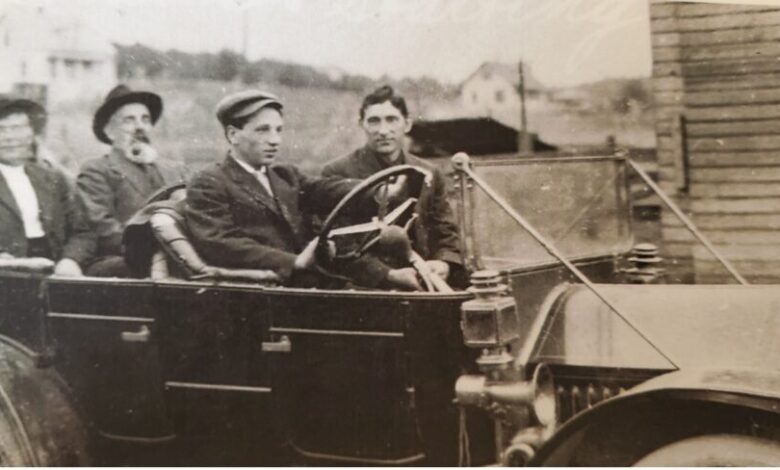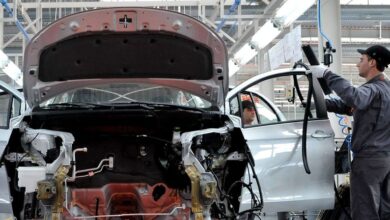History: Edmonds enters the automobile age


Despite the fact that Seattle-based cars had traveled the rough dusty or muddy roads to visit Edmonds for a couple years, it wasn’t until June 1911 that A.M. Yost became the first Edmonds resident to own an automobile.
A.M. Yost, the patriarch of the highly successful Yost family, had increasingly become frustrated by the lack of safe, convenient transportation for Edmonds citizens. A trip to Seattle via horse and buggy or a steamboat was fraught with delays and difficult travel conditions. Additionally, to reach the Interurban railway, people were required to walk a couple miles east on rough roads to the pick-up station. The Interurban also had proven to be unsafe; several nighttime robberies had occurred when citizens were traveling home from work.
With Yost’s purchase of a new Everett 30 automobile manufactured by the E.M.F. Motor Company out of Detroit, it provided the Yost family with the possibility of traveling faster and farther than ever before.


Author’s note: The E.M.F Company was an early American automobile manufacturer that produced automobiles from 1909 to 1912. The name E.M.F was gleaned from the initials of the three company founders: Barney Everitt (a custom auto-body builder from Detroit), William Metzger (formerly of Cadillac), and Walter Flanders (who had served as Ford’s production manager). The car’s name for some unknown reason was spelled differently than the surname of one of the three founders.
The June 23, 1911 Edmonds Tribune-Review reported the arrival of the new car. The article read:
“A.M. Yost is the proud possessor of the only automobile in town. It is an Everett 30 and it is a splendid machine. George Yost, his son, is the chief chauffeur and has so far graduated, so that he can lie on his back and fumble with the internal organs of the engine with a monkey wrench in as dignified and professional a manner as any of the high priced and imported mechanics.”
A month later, another Edmonds resident — Henry Erben Jr. — took possession of a second Everett 30 after taking several rides with the Yost family.
The Edmonds Tribune-Review again reported on its arrival and the owner’s initial experiences.
“Henry Erben Jr. took possession of his new Everett 30 automobile this week. Henry was carefully instructed in the mysteries and art of the new conveyance and is already proving to be something of a driver himself.”
They do say, however, that the first time he ventured downtown in the machine he had an occasion to stop in front of Attorney White’s office and that he was extremely surprised when the affair did not stop when he hollered “Whoa” and did not recover sufficiently to put on the brake until he had gone some small distance beyond.”


In 1912, the purchase of automobiles remained almost non-existent in Edmonds. A.M. Yost bought a new Cadillac, replacing his Everett 30, and real estate developer F.W. Peabody purchased a Ford to show his clients around. In addition to these purchases, E. H. Heberlein opened a Studebaker/Flanders automobile dealership through his Edmonds Hardware Store but apparently didn’t sell any cars until early 1913.
Author’s note: Flanders was to become one of several short-lived Detroit-based automobile manufacturers during this period. (1909-1913)


The early automobiles proved hard to maintain, needing regular tune-ups, and often were hard to start. To start the engine, a hand crank had to be used. If the car backfired while the crank was in use, the person could be seriously injured if they did not let loose of it — as the backfire caused the crank to rotate rapidly in the opposite direction. Such was the case for George Yost in late 1911 when he badly injured his hand while trying to start the Everett 30. In March 1913, T.T. Barbour broke his wrist when the engine of his Flanders backfired while he was attempting to start it.


Throughout 1912, A.M. Yost and his family traveled extensively to visit family and friends in Washington and Oregon. The trips, however, were not without challenges and problems. The 4 1/2-inch tube tires were prone to being punctured by rocks in the road and needed to be patched. Joseph Yost, A.M.’s second oldest son, mentioned one trip that his parents took to the Three Sisters area in Oregon. “The automobile suffered numerous tire problems along the way. Eleven repairs and patches were made to damaged tires and a mechanical problem forced an overnight stay in a peach orchard.”
The vehicles also proved to be hard to steer on the rough ruddy roads in and around Seattle and Edmonds. The most notable accident occurred in June 1912, when George Yost collided with a taxicab on a muddy 2nd Avenue in Seattle, while driving his father’s new Cadillac. According to the family’s written history, George and his friends were shaken up by the accident, but the car was not severely damaged. No mention was made of the taxicab or its driver.
Despite the challenges with the early models, A.M. Yost remained an avid enthusiast and believer in the future of the automobile. With the announcement of the new 1913 self-starting, 50-horse-power, eight-cylinder Cadillac, A.M. Yost immediately placed an order for the car, and made arrangements to pick it up at the Detroit plant in February 1913.
A.M. Yost, his wife Amanda and several family members traveled to Chicago on the Chicago, Milwaukie, St. Paul railroad, and then by train to Detroit. After picking up the car, the family traveled extensively throughout the East Coast, visiting family, and then drove back across the country. They arrived in Edmonds in August, after traveling 8,716 miles without any major difficulties, which was largely unheard of then.


Seeing the reliability of the 1913 Cadillac, A.M. Yost urged his sons to enter the car in the Seattle Post-Intelligencer Reliability Tour events, which included road races from Seattle to Portland and from Seattle to Canada.




But it wasn’t all fun for A.M. Yost. By the autumn of 1913, there were reportedly over 20 automobiles in the Edmonds and Richmond Beach area and more on order. As was his trademark, he saw a large business opportunity surrounding the need to service and repair automobiles. As a result, he and his sons formed a company, A.M. Yost & Sons, and started building a concrete garage at the corner of 5th and Dayton in December 1913.
The March 27, 1914 Edmonds Tribune-Review stated:
“The garage is as complete as can be found in any city of its size in the state. It measures 60’ X 90’ with entrances on both streets and a plate glass front. It has a concrete floor with drainage, office in front with a large work room in the rear and a room large enough to store twenty automobiles.”
There was also cold and hot water and a tank to store “free air,” and it had a galvanized iron roof. The building was then leased to the Yost Auto Company, another newly formed company owned by A.M. Yost’s three sons — George, Jake and Sam Yost. The garage opened for business in May 1914 and soon after the Yost brothers acquired an agency to sell “the celebrated little Ford car” and later added a Buick dealership.
The garage additionally had a large storage tank built underground to hold gasoline. But surprisingly, the gas pumps were installed just inside the garage door, which meant cars had to be driven into the garage to be fueled.
As Lillie Astell (the granddaughter of A.M. Yost) explained in her oral history:
“Such an arrangement provided for the security of the fueling facility when the garage was closed.
One day we had been out riding with my grandfather and at the end of the trip he decided to fuel up before going home. He parked the car appropriately for fueling, inside the garage, and we all got out of the car to watch the interesting operation. After several gallons had been hand-pumped into the automobile’s tank, the process was stopped to see how full the tank was. The car was rocked sideways, but that didn’t indicate too well how much room there was still unfilled in the tank. The attendant tried looking down the filling neck to see if he could see the gasoline level, and that was not satisfactory. Then a brilliant idea came to him. It was dark inside the tank so obviously all that was needed was a light to see the gasoline level. The easiest way to get light was to light a match and look down the loading neck – which was promptly done. However, before the attendant could get close enough to look down the neck a loud whooooosh occurred and the gasoline fumes had ignited and there was a vigorous fire burning at the edge of the gasoline tank.
I believe I was about 7 years old and not too sure about these new fangled automobiles, having heard how dangerous they were and how bad gasoline fires were. With the first whoosh and flame, I took off up Dayton Street and I believe it only took me three steps to get up to the old Congregational Church which was one block away, on the corner of Sixth and Dayton.
Fortunately fire extinguishing equipment had been provided in the garage and the fire was quickly extinguished, and there was little damage to the car, and fortunately the attendant wasn’t burnt.
This experience with the ‘boss and his car’ persuaded management that the safest place for the gasoline pumps was outside the garage, and that matches were not to be used around any of the gasoline tanks.”




From the day the garage opened until August 1915, the Yost Auto Company’s garage and associated businesses proved to be extremely successful, with A.M. Yost often visiting and encouraging motor travel, and improved transportation via better roads and bus lines for school aged children and citizens.
In August 1915, A.M. Yost arranged a motor trip to Wenatchee to visit friends. His son Dan and his family accompanied A.M. and his wife Amanda on the trip. They drove over Snoqualmie Pass the first day, camping on the hospital grounds in Cle Elum for the night. In the morning they drove over Blewett Pass, which was at the time was little more than a trail through the mountains, and arrived at the fruit orchard of friends near Wenatchee. They camped there the second night.
The next day included a sightseeing trip to Lake Wenatchee. While departing the lake, they experienced tire trouble. After changing the tire, the party got back into the car and A.M. Yost, who was driving, felt dizzy and fell into unconsciousness. Dan Yost drove him and the family to the hospital in Leavenworth, which was close by. A.M. Yost, at age 59, died there that evening, having suffered a massive stroke. Upon his death, A.M.’s body and family were transported back to Edmonds by train, and the car was shipped back later. A funeral was held at the Edmonds Opera House the following week and attended by hundreds of community members.


After A.M. Yost’s passing, the Yost Auto Company and his sons continued to carry on his vision and wishes regarding improved transportation and motor travel. The company expanded into providing bus transportation for the local school districts as well operating the first successful bus line between Seattle and Edmonds. A second floor was added to building to provide space for repairing and servicing their buses and the building acted as a bus terminal as well.
After being in the motor travel business for 33 years, the Yost brothers sold the Yost Auto Company to their niece Lillie Astell, (daughter of their older sister Carrie Yost Astell), and her husband Fern “Slim” Rittenhouse, Bernard Yost and Lester Wilson. All had been associated with the Yost Auto Company for years. The new ownership group rebranded the company as the Edmonds Motor Company, although most people still referred to the original garage as the Yost Garage.
The following year, the owners purchased the adjoining property, extending south to Maple Street, which had been owned by Long Motor and Welding Company. They tore down the old building and erected a modern Chevron service station, which opened in January 1948.


The Edmonds Motor Company continued in business for over two decades. In 1973, the entire block between Dayton and Maple Streets was purchased by J. Ward Phillips. The property was remodeled and upgraded, housing an antique mall on the second floor of the old garage and a variety of boutiques, shops and businesses on the lower level, extending the length of the block. The new complex was named Old Milltown.


In 2007, the block went through another upgrade. The nearly 95-year-old garage needed significant repairs. The building was extensively remodeled while maintaining its original architectural design. Today the old garage building is the home of the Edmonds Vision Center and Las Brisas Mexican Restaurant. Adjacent to the south is the beautiful Hazel Miller Plaza. The plaza provides comfortably seating amongst a variety of plants as well as photo displays of the original Yost Auto Company and the Edmonds Motor Co. The businesses behind the plaza include Gelato Caffe, Canarino, Milltown Nails & Skincare, Oasis Tea Zone and Vinbero – A Natural Wine Bar.
Author’s final notes: A.M. Yost was a visionary when it came to motor travel and the benefits it would provide. Without his vision the adoption of automobiles, the improvement of roads and reliable bus systems would have taken much longer to materialize.
It should however be noted that there were automobile detractors too. Articles in the Edmonds Tribune-Review raised concerns about the noise, smell and disruptive nature of automobiles on the city’s streets. Complaints ranged from the amount of mud, water and manure that the cars speeding at 10 to 15 mph kicked up, to the opportunities that automobiles provided men to drive to “wet” areas where they could drink, gamble and be involved in other worldly vices.
This article was researched and written by Byron Wilkes. Thanks go to the Edmonds Historical Museum, Sno-Isle Genealogical Society and the Everett Library’s Northwest Room for their research assistance.



